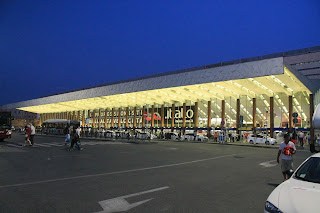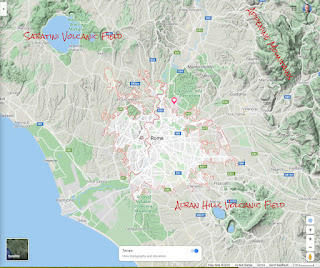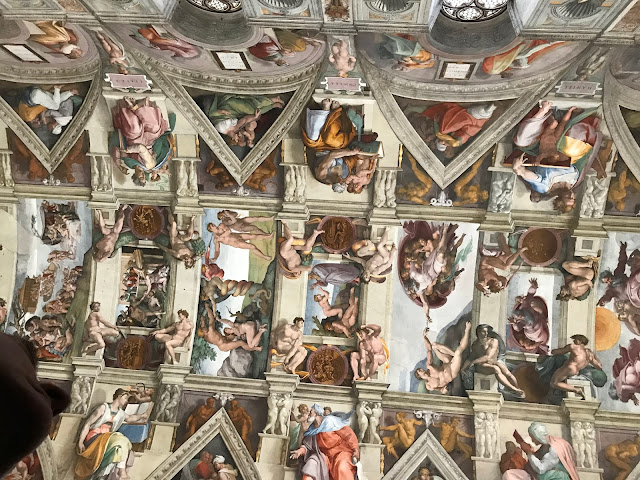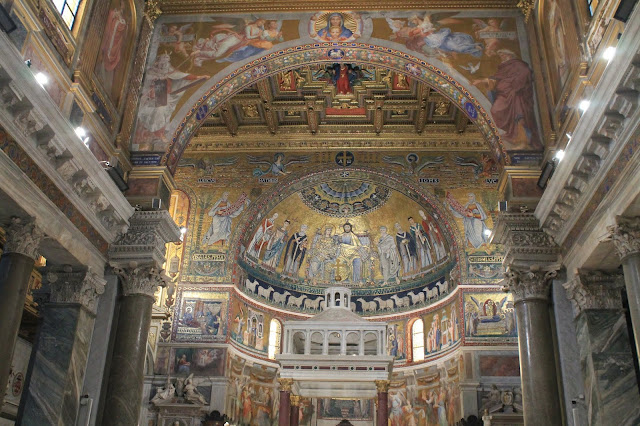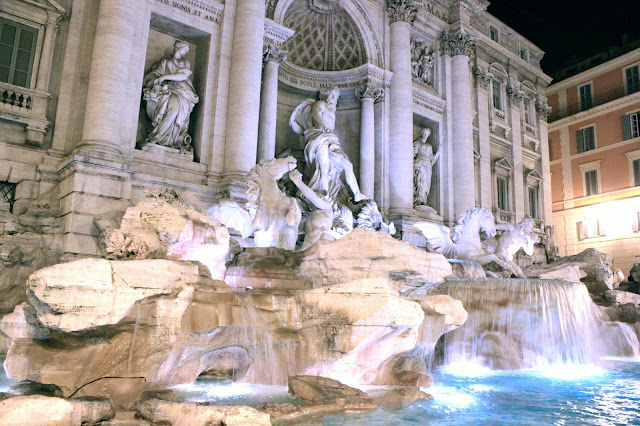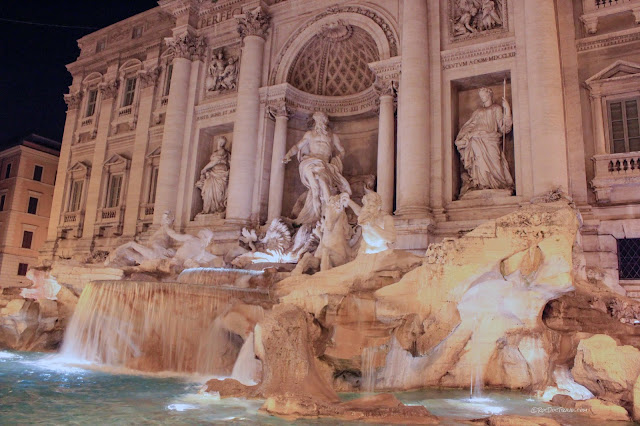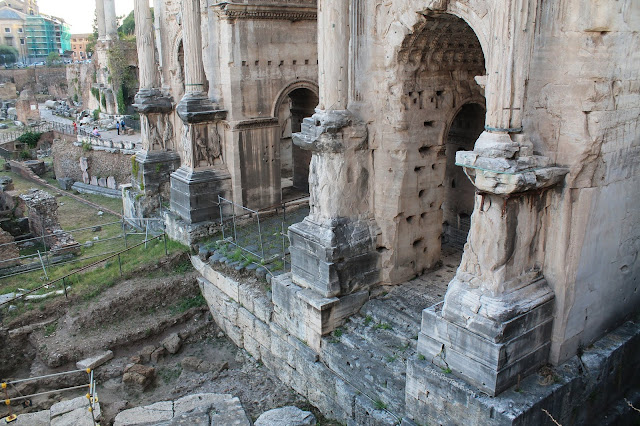Rome
Rome, Italy
A geologic perspective you won't find anywhere else!
Travel to Rome
Interactive Google Map of Rome. You can move and zoom.
It's so easy to find excellent travel websites about Rome that I'll just give my own perspective here. But I'd like to add that I've found Rick Steves' guides to be spot-on and indispensible.
Lodging: I like to stay near the train station (Roma Termini) so that I'm not hauling luggage all over the city. Subways and buses are also available there, so it's very convenient for getting around. Rome has exceptional Air B&Bs, too.
Vehicles: Just don't try to drive in Rome! You'll thank me later.
Food: Get away from the touristy neighborhoods! Rome is the best place to be adventurous, so follow your nose and the locals. My favorite place is Tonnarello in Trastavere, south of the Vatican.
Water: The public fountains (marked) are drinkable. This is one of the best features for travelers in all of Europe! I'm usually waaay too thirsty as I travel, but not in Rome!
Walking: Hit the streets to see, feel, smell, and taste what Rome really is. Wear soft or shock-absorbing shoes! The cobblestones are quaint, but they're hard on your feet.
Street Sellers: Just try to ignore them. They're getting more aggressive every year. Don't fall for their smiles -- "never smile at a crocodile!"
Geology of Rome
Modern Rome and the Roman Empire are inseparably connected to their geologic setting!Rome sits on eroded layers of consolidated volcanic ash (called tuff) from the Alban Hills volcanic field southeast of the city. Wherever you see the brown, gritty rocks in the hills or building stones, that's the tuff. Additional tuff and lava flows were also quarried from north of the city in the Sabatini volcanic field. Romans liked the tuff because it is structurally strong, but easy enough to cut that it was economical. It's even used as cobblestones in the streets of Trastavere.
Perhaps the most important rock used in Rome is travertine, a spring-deposited limestone. You can recognize it by its typically pale off-white color and uneven layered appearance. It can also be tan, yellow, or brown. Travertine is often mistaken for marble because they're both fundamentally made of calcium carbonate (calcite), but marble has been recrystallized by pressure or heat and is solid, whereas travertine often has small voids. Travertine is still quarried in huge amounts at Ponte Lucano northeast of Rome. Ponte Lucano quarries: 41.960113, 12.742858
The Apennines are a fold & thrust belt where western Italy is being squeezed against eastern Italy by movement of the African and European tectonic plates. One result of that collision was creation of marble by metamorphosis of limestone. This is the structural marble found all over Rome including the Colosseum, Forum, and Vatican.
The famous Carrara marble used in statues is still quarried in NW Italy. It's not the structural marble we'll discuss here. Quarry: 44.096655, 10.134988
In addition, the Romans brought rocks, including obelisks and columns, from Egypt, Greece, Turkey, and northern Africa. These include all the red granite, colored marble & breccia, and black statues you'll see in Rome.
Bricks & Concrete
The Romans perfected the formula for and use of concrete, without which their empire would never had achieved the massive scale of structures and advancement of architecture, nor the longevity of these structures.The secret to Roman cement was the use of volcanic ash (pozzolana) rather than the slaked lime used before, or the silica additives used today. The chemical composition of the pozzolana caused it to actually harden over time when exposed to salt water, compared to modern concrete that disintegrates within decades.
Romans perfected the firing of bricks early in their history. Mass production of kiln-fired bricks allowed rapid and large-scale construction of the empire. You'll see that ancient Roman bricks are typically quite a bit thinner than modern bricks. This has an advantage the Romans didn't know about -- seismic engineering! Having many thin layers of bricks allows the structure to shift and move without major fracturing.
Rome Rocks!
The Vatican
The Vatican is shielded behind an ancient brick and stone wall. This picture is near the Vatican museums.One of the first displays in the Vatican Museums is these huge geode slabs. Each is nearly a meter in diameter. Geodes form when silica-saturated groundwater fills voids underground, often in volcanic ash. Quartz crystals and non-crystalline quartz (chalcedony) grow, filling the void.
This Egyptian black granite (gabbro) statue has veins of white quartz that formed when the granite fractured, and silica-saturated groundwater deposited quartz in the veins.
Statue of the Nile Recumbent (1st or 2nd century Rome) is made of banded dark gneiss.
This Egyptian Lion-Thing is made of black granite with large feldspar crystals. That kind of texture is called "porphyritic."
Here's a close-up of The Lion Thing.
The museum houses hundreds of statues from ancient Rome, Greece, and Egypt.
"New Wing" hall of statues.
This pillar is made of banded marble.
"Breccia" is a fractured rock that has been re-cemented. This breccia is made of limestone, and has also been metamorphosed to marble. Most of the Rome breccia came from northern Africa.
This marble statue of the River Nile personified is an 18th century copy of a 2nd century Roman original.
I could hardly believe this bathtub carved from a single block of granite! It's Egyptian.
And this enormous basin carved from red porphyritic granite is amazing! It likely weighs a few tons (granite is about 2700 kg per cubic meter). Those ancient Romans were quite the engineers to make and transport it! It's in the Sala Rotunda. The floor is 3rd century mosaics taken from Otricoli and Sacrofano.
The Vatican museum has a large collection of mosaics made from precious stones. These use a lot of blue lapis lazuli.
Another scene made from precious stones.
From the museum, you get occasional views of St. Peter's Basilica.
The door frames are red limestone, likely from north Africa.
When I saw this big precious stone table, my jaw hit my chest! Look at all the different materials -- blue lapis lazuli, patterned marbles, red granite, green granite! These came from all around the Roman empire.
Okay, no rocks here, but the Sistine Chapel's ceiling is so amazing, no trip to Rome would be complete without it! You can take a 360 degree virtual tour of the Sistine Chapel here: link
The Sistine Chapel floor is mosaics of marbles and granites from all around the Mediterranean.
St. Peter's basilica is one of those places you have to see in person to appreciate. It's bigger, more beautiful, and holier than pictures can show. It's made of a lot of marble pilfered from the Colosseum (which used to be sheathed in white marble) and rock from all over the Roman empire.
Michelangelo's Pieta is made of translucent Carrara marble. Its glowing beauty must be seen to be believe! This statue moves me more than any other.
To rest your neck from looking up, take some time to look down, too! The floors are a wonderland of marbles and granites from all over the empire.
Most of the statues are Carrara marble.
Bernini's glorious Baldachino with its twisted bronze columns is an eye-popping 94 feet tall! The golden Chair of St. Peter behind it is visible from 600 feet away at the basilica entrance.
St. Peter's is beautiful!
The fractured-looking marble is metamorphosed limestone breccia from north Africa.
This is a particularly stunning use of various marbles. Just look at the draped marble "fabric!"
Fossil shelled animals were metamorphosed in this red marble.
The basilica is sheathed in white marble from the Colosseum.
In Rome, turn around once in a while as you walk, or you could miss amazing views like this one.
The City, Pantheon, Trevi Fountain, Spanish Steps
The Tiber River, at low flow here, can rise dramatically in the biggest storms. To combat floods, the young Italian government built these high embankment walls between 1875 and 1910 after a historic flood in 1870 nearly ruined celebration of the newly unified country. Low areas of Rome, like the Forum, still rely on a drainage system started by the ancient Romans.The last flood to top the embankment walls was in 1937. When a city is as old as Rome, its inhabitants learn -- and pass down -- just how high the river can get. That knowledge is invaluable, and has protected many European cities from major flood damage. On the flip side, American cities (excepting only a handful) are too young to have experienced their rivers' full potentials, and so we are continually surprised by big floods, and give them ominous (but meaningless) names like "100-year flood" or, worse yet, "500-year flood."
This excavation is uncovering the oldest masonry sport stadium. While walking around Rome, you'll see excavations and ruins all over.
The Pantheon was completed in about 125 A.D., and is the oldest unreinforced concrete dome in the world. Originally a Roman temple, it was later changed into a Christian church. The columns and obelisk were brought from Egypt. When I visit Rome and London, I wonder if anything is left in Egypt or Greece!
This dome is an engineering feat! Learn more about it here: link
The Pantheon floor includes granite and colored marbles from conquered Egypt, Carthage, and elsewhere in the Middle East. The disks are granite from Egypt.
It takes patience to get a picture of the floor in a place as busy as this!
The thin Roman bricks are a key to the longevity and stability of the Pantheon. They slip and give just enough to save the building from earthquake damage.
Yellowish marble columns in the Pantheon came from Turkey.
The stone parts of the 16th century Fontana dei Fiumi in Piazza Navona is made of travertine. You can identify travertine by its vuggy layering (layers of small cavities).
Basilica di Santa Maria in Trastevere was started in the 340's, and mostly built in the 1140's, making it Rome's oldest church.
The church is famous for its 12th and 13th century golden mosaics. They're really stunning -- make sure you go see them!
Closer view of the gilded mosaics. They're as beautiful, stunning, and worth seeing as anything in Rome!
Santa Maria's floor has some spectacular stone mosaics.
No, this isn't the Colosseum! It's the ancient travertine Teatro Marcello that has a modern building built onto it.
Here's an outcrop of the Alban Hills volcanic tuff in the Aventine Hill west of the Forum. You can recognize the tuff building stones by this characteristic brown color and gritty texture (I always touch the rocks!). Notice that its cliff is apparently stable, making it a good candidate for a building stone.
White Botticini marble from northern Italy was used in the huge Victor Emmanuel Monument.
Trajan's Column is made of twenty cylinders of Carrara marble. Be sure to read about this before you go see it so you can appreciate the amazing stories it tells!
Ah, the Trevi Fountain! Finished in 1762 by Pannini, its base (the rock) is made of travertine from Ponte Lucano, and the statues above are Carrara marble. It is an impressive 85 feet tall and 160 feet wide. In "Roman Holiday," watch for kids climbing and wading in the fountain! Audrey Hepburn's hair salon is just off the right edge of this picture.
All of the lower yellowish cliffs are travertine -- appropriate, since travertine is a spring deposit!
The Spanish Steps are also made of travertine. As you walk or sit on them, look for the characteristic layering formed while water deposited limestone layer by layer.
The Forum and Colosseum
Marble pillars in the Forum came from various locations including northern Africa, Turkey, Greece, and Carrara.
These pillars at San Lorenzo in Miranda in the Forum show the effects of acidic rain on soluble calcium carbonate. The columns have slowly dissolved over the centuries.
The Colosseum was originally faced with marble, which was later pilfered for St. Peter's basilica. The structural walls are made of travertine and tuff, with inner walls of brick and cement. You'll see squarish holes where marble facing was removed -- these were attachment points.
A little of the original marble facing remains. I guess these were pieces they couldn't use at St. Peter's.
Most of the inner Colosseum is brick and tuff. Walkways are travertine.
I was surprised to see how much of the Colosseum is missing. Look at the patterns in the high wall, and you can see where stairways and upper levels used to be attached. The south side of the Colosseum (this picture is the north side) collapsed in an earthquake in 1349. It turns out, the south side was built on river gravels while the north side is on tuff bedrock. Softer materials shake harder in earthquakes.
Latter-Day Saints Temple
Northeast of the city center is this gorgeous modern church built by the Church of Jesus Christ of Latter-Day Saints in 2019. It's worth a visit just to see modern recreations of 19th-century Carrara marble statues by Danish sculptor Bertel Thorvaldsen.The temple is faced with "Bianco Sardo" granite quarried near Ala Dei Sardi on the island of Sardinia. Quarry location: 40.626016, 9.284713
This is an exact duplicate of Thorvaldsen's original Christus statue in the temple visitor center. The original is in the Church of Our Lady in Copenhagen, carved in about 1820. It stands 3.45 meters tall, and has an amazing reverence about it.
These are exact Carrara marble duplicates of Thorvaldsen's 12 apostle statues, originally completed in 1848 in Copenhagen.
Other Posts: topic "Italy"

